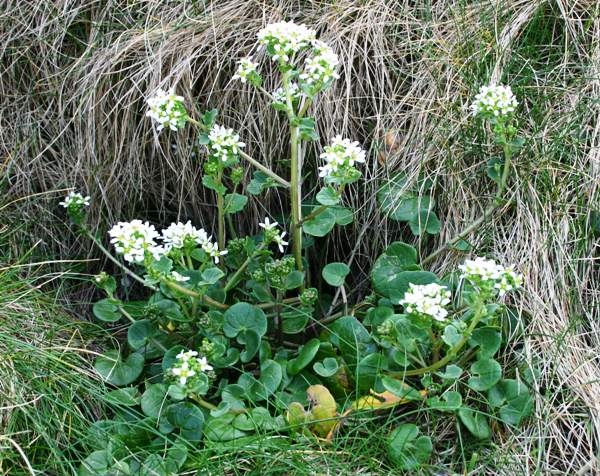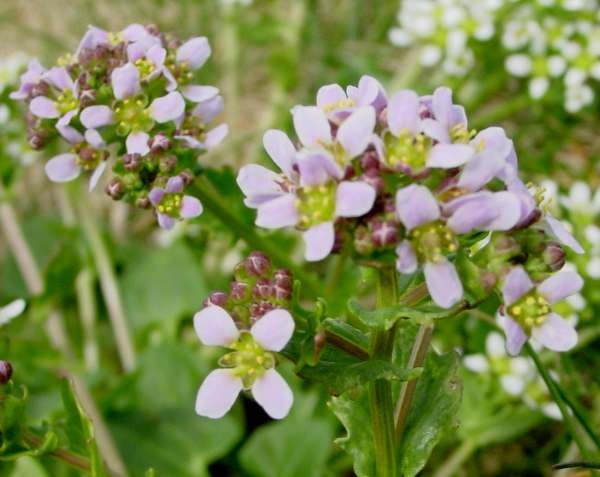Cochlearia officinalis - Common Scurvy-grass
Phylum: Magnoliophyta - Class: Equisetopsida - Order: Brassicales - Family: Brassicaceae

The shaded hedgerows and ditches of Pembrokeshire (and many other coastal parts of Britain and Ireland) are lit up in springtime by the brilliant white but short-livedflower-masses of Common Scurvy-grass.
Description
Usually 15 to 40 cm tall, this untidy biennial plant is best admired from a distance. Its succulent lower leaves, varying from dark green to red and even deep purple, are held close to the ground.

The fragrant, four-petalled flowers, 8 to 15mm across, are usually white but sometimes tinged with mauve or purple. Once the short-lived petals have fallen from the flowers, roundish seed pods swell and ripen.
Distribution
Found throughout Britain and Ireland, Common Scurvy-grass occurs also in coastal regions of northern and central Europe; it is also found, although much less frequently, in some mountainous inland locations.
Habitat
This plant is common only near the coast, where it grows on grassy cliffs, in salt marshes and on coastal roadside lanes where winter salting adds to the natural salinity. Inland locations near salt mines and saline springs are also favoured by Common Scurvy-grass.

Heavily salted main roads inland sometimes have central reservations and verges lined with Common Scurvy-grass, but more often the species seen there is the much smaller Danish Scurvy-grass Cochlearia danica. Surprisingly, in view of Common Scurvy-grass's apparent craving for salt, there are also some mountain sites in northern England and in Scotland where Cochlearia officinalis has been recorded.
Blooming Times
The first flowers appear in April, but May is the best month for this member of the Cabbage family. You will see odd patches of scurvy-grass inbloom throughout the summer.
Uses
Sailors ate scurvy-grass when at sea to ward off the debilitating diseaseof scurvy, which is caused by a deficiency of vitamin C.

The symptoms of scurvy are spongy and bleeding gums, bleeding beneath the skin, and extreme weakness. The sharp-tasting leaves of this plant are very high in vitamin C, and at one time scurvy-grass ale was a popular tonic drink. In herbal medicine Cochlearia officinalis was used for its antiseptic properties.
Etymology
Cochlearia, the generic name, comes from the Greek noun kochlarion, meaning a spoon; it is a reference to the spoon-shaped lower leaves of plants in this genus.
The specific epithet officinalis is Latin and translates to 'official' - a description that was applied to many plants that were deemed to be of high pharmaceutical value.
The common name is sometimes written as Scurvygrass or occasionally as Scurvy Grass.
Similar Species
Several similar Scurvy-grass species occur in Britain and Ireland, but the two most common species are Cochlearia officinalis and Cochlearia danica.
The Common Scurvy-grass plants shown on this page were photographed on the Pembrokeshire Coast Path during early spring.
Sue Parker's latest ebook is a revised and enlarged second edition of the acclaimed Wildflowers in the Algarve - an introductory guide. Full details here...
Buy it for just £3.95 on Amazon...
Please Help Us: If you have found this information interesting and useful, please consider helping to keep First Nature online by making a small donation towards the web hosting and internet costs.
Any donations over and above the essential running costs will help support the conservation work of Plantlife, the Rivers Trust and charitable botanic gardens - as do author royalties and publisher proceeds from books by Pat and Sue.



